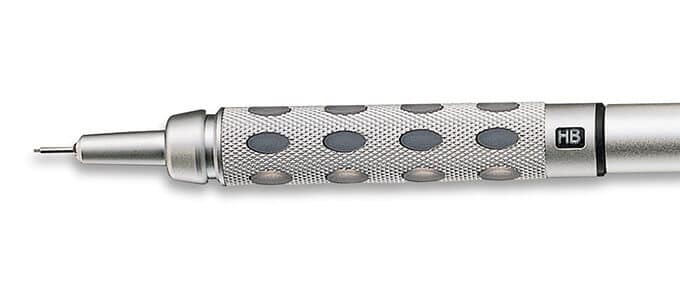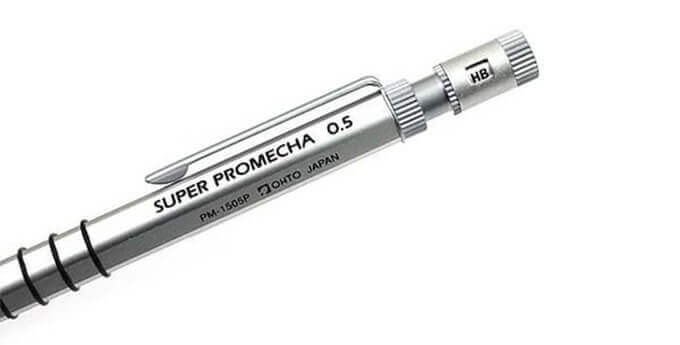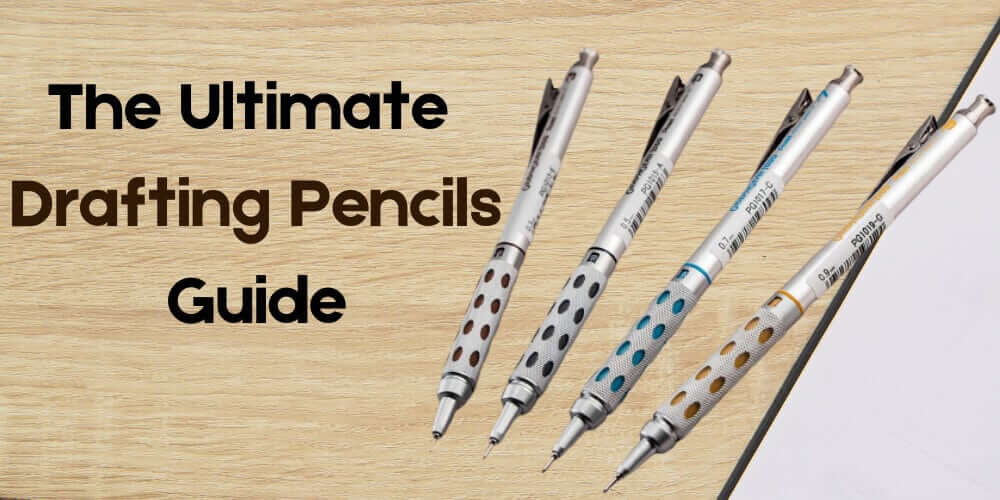What is a Drafting Pencil?
A Drafting pencil/Technical pencil is a particular type of mechanical pencil used by architects, drafting technicians, and designers for precision technical drawing.
They have a long slim lead sleeve/guide pipe to aid in marking straight lines with rulers and stencils. It also allows an unobstructed view of the pencil lead for greater precision.
This guide will cover what we use them for and how they differ from regular mechanical pencils, lead grades, and diameters. We also have an extensive list of the best drafting pencils.
Table of Contents
1. What Are Drafting Pencils Used For?
Mechanical drafting pencils are used to create precise technical drawings.
Most modern draftsmen use a software program to produce their technical drawings. We know this as CAD computer-aided design. AutoCAD, Inventor, and Solid Works are some of the more popular programs.
As good as CAD software is, many colleges and universities still teach their students how to use drafting pencils for technical drawing.
It gives them perspective in using line weights, creating lettering that is clear and consistent, and hatching, shading, and textures. As well as being able to create documents on the fly with no computer required.
2. Drafting Pencil Features
Drafters use technical pencils to create precision technical drawings. They are a high-quality mechanical pencil that has the following features.
2.1. Rugged Design
Architects were among the first professions to use drafting pencils and would often work on construction sites. This lead to drafting pencils having a rugged design that could stand up to the rigors of this environment.
Today, we mainly use them in office environments, but they have kept their rugged design.
They use sturdy materials in their construction, including aluminum, brass, and heavy-duty plastics.
Brass and aluminum drafting pencils often have a knurled grip that allows a firm grip, giving greater control and precision when using the pencil.
2.2. Narrow Lead Sleeve

To enable a drafting pencil to mark alongside a straight edge and give an unobstructed view, a drafting pencil has an elongated round lead sleeve.
They sometimes refer to the lead sleeve as a guide pipe. It is usually 3 – 5 mm, with its internal diameter slightly bigger than its lead diameter.
The sleeve can be either fixed or retractable (pocket safe)
2.3. Lead Dispensing Mechanism
Drafting pencils dispense a small fixed amount of lead with each click of the push button from the lead sleeve. The length of the lead dispensed differs between manufacturers.
The exception to the rule is the OHTO Promecha 1500P, where the amount of lead dispensed can be adjusted with each click from 0.2 mm – 2.0 mm.
2.4. Lead Sizes / Diameters
Technical pencils/Drafting pencils are usually available in 0.3 mm, 0.5 mm, 0.7 mm, and 0.9 mm diameter. However, there can be some confusion as some pencils may be labeled 0.35 mm yet take 0.3 mm leads.
0.35 mm leads are so close to 0.3 mm that no one makes 0.35 mm lead. The same is true for 0.9mm and 1.0mm.
Check out The Ultimate Guide to Mechanical Pencil Lead Sizes for more information.
Japanese pencil manufacturers such as Pentel and Staedtler manufacture 0.4 mm, 1.3 mm, and 2.0 mm diameter drafting pencils.
2.5. Lead Hardness/Grade
Usually, architects and designers want crisp, sharp lines and favor harder lead grades in the H range on the graphite pencil scale. Although there may be occasions where they will use a softer, darker lead but no lower than a 2B.
For more information, check out our Graphite Pencil Scale Ultimate Guide.
2.6. Lead Grade Indicator

Another common feature of a drafting pencil is a lead grade indicator.
This is usually a slot in the pencil cap that displays the lead grade marked on the body.
To select your pencil’s lead grade, turn the cap until you display the required grade. A typical lead grade range is B – H4.
2.7. Eraser
Nearly all drafting pencils will have an eraser located underneath the pencil cap. However, it is pretty small and probably best used when you don’t have a regular-sized eraser available.
2.8. Pencil Lead Clean Out Rod
A pencil lead clean-out rod is a device used to clear broken lead jams from mechanical pencils. It comprises a thin, strong wire attached to something more significant, which you can then grip.
To clear broken lead, insert the clean-out rod’s wire into the lead sleeve, push it back into the barrel and remove it via the larger refill hole.
If a drafting pencil has a clean-out rod, they usually attach it to the underside of the eraser holder.
2.9. Balance & Weight
Drafting pencils are a precision writing instrument that is perfectly balanced and weighted to ensure maximum comfort and control when writing and drawing.
3. Drafting Pencils Vs. Mechanical Pencil
Drafting pencils are mechanical pencils with many features designed to aid architects and designers in producing a technical drawing.
The fundamental difference between a regular mechanical pencil and are drafting pencil is that regular pencils have fewer features.
Regular Mechanical Pencil Features:
3.1. Construction
They manufacture general-purpose mechanical pencils from cheaper materials such as plastics and are not as robust as drafting pencils.
Luxury brands use stainless steel to manufacture their mechanical pencils, but these are premium-priced and intended for the gift market.
3.2. Lead Sleeve
Mechanical pencils have a lot shorter lead sleeves than drafting pencils up to 2.0 mm. Sometimes they don’t have a sleeve; they taper the end of the barrel to a narrower point.
3.3. Lead Size
We use mechanical pencils for writing, drawing, and sketching and usually have 0.5 mm or 0.7 mm lead.
There are particular mechanical pencils known as clutch pencils or lead holders with larger lead diameters, i.e., 2.0 mm, 3.25 mm, and 5.5 mm.
Artists use these for drawing and shading larger areas.
3.4. Lead Dispensing Mechanism
A Mechanical pencil dispenses a greater amount of lead with each push button click than the small precise amounts dispensed by drafting pencils.
3.5. Lead Grade Indicators and Pencil Lead Clean Out Rods
Mechanical pencils that are used for everyday writing and drawing rarely have lead grade indicators and pencil lead clean-out rods. These are usually features reserved for the more expensive and better quality mechanical drafting pencils.
4. Who Makes The best Drafting Pencils
The big brand name Japanese and German pencil manufacturers make the best drafting pencils. The following list includes the best technical drawing pencils made by these companies:
- Faber-Castell TK-Fine Vario L Mechanical Pencil – 0.35, 0.5, 0.7, 1.0 mm.
- OHTO Promecha Mechanical Pencil – SP-500P – 0.3, 0.5, 0.7, 0.9 mm
- OHTO Promecha Mechanical Pencil – OP-1000P 0.3, 0.5, 0.7, 0.9 mm
- OHTO Super Promecha Mechanical Pencil – PM-1500P – 0.3, 0.5,0.7 0.9 mm
- Pentel 120 A3DX Drafting Pencil – 0.3, 0.5, 0.7 0.9 mm
- Pentel Graph 1000 for Pro Drafting Pencil – 0.3, 0.4, 0.5, 0.7, 0.9 mm
- Pentel Graph 1000 Mechanical Pencil – PG1000 – 0.3, 0.4, 0.5, 0.7, 0.9 mm
- Pentel Graph 1000CS Creator’s Style Drafting Pencil – 0.3, 0.5 mm
- Pentel GraphGear 1000 Drafting Pencil 0.3, 0.4, 0.5, 0.7, 0.9 mm
- Pentel GraphGear 500 Drafting Pencil – 0.3, 0.5, 0.7 0.9 mm
- Pentel GraphGear 800 Drafting Pencil – 0.3, 0.5, 0.7, 0.9 mm
- Pentel Graphlet Mechanical Pencil – PG500 – 0.3, 0.4, 0.5, 0.7, 0.9 mm
- Pentel P200 Series Mechanical Pencil – 0.3, 0.5, 0.7, 0.9 mm
- Pentel PG5 Slim Drafting Pencil – 0.5mm
- Pentel Sharp Drafting Pencil – 0.3, 0.5, 0.7, 0.9 mm
- Pentel Smash Drafting Pencil – 0.3, 0.5, 0.7, 0.9 mm
- Pilot S10 Drafting Pencil – 0.3, 0.4, 0.5, 0.7, 0.9 mm
- Pilot S20 Drafting Pencil – 0.3, 0.5, 0.7, 0.9 mm
- Pilot S3 Drafting Pencil – 0.3, 0.4, 0.5, 0.7, 0.9 mm
- Pilot S5 Drafting Pencil – 0.3, 0.4, 0.5, 0.7, 0.9 mm
- Platinum Pro-Use 171 Drafting Pencil – 0.3, 0.5, 0.7, 0.9 mm
- Platinum Pro-Use Drafting Pencil – 0.3, 0.5, 0.7 mm
- Platinum Pro-Use I Drafting Pencil – 0.3, 0.5, 0.7 mm
- Platinum Pro-Use II Drafting Pencil – 0.3, 0.5, 0.7 mm
- Platinum Pro-Use Original Drafting Pencil – 0.3, 0.5, 0.7 mm
- Rotring 300 Drafting Pencil – 0.35, 0.5, 0.7 mm
- Rotring 500 Drafting Pencil – 0.35, 0.5, 0.7 mm
- Rotring 600 Drafting Pencil – 0.5, 0.7 mm
- Rotring 800 Drafting Pencil – 0.5, 0.7 mm
- Rotring 800+ Drafting Pencil + Stylus – 0.5, 0.7 mm
- Rotring Rapid Pro Drafting Pencil – 0.5, 0.7 mm
- Staedtler 925-15 Drafting Pencil – 0.3, 0.5, 0.7, 0.9 mm
- Staedtler 925-25 Drafting Pencil – 0.3, 0.5, 0.7, 0.9, 1.3, 2.0 mm
- Staedtler 925-35 Drafting Pencil – 0.3, 0.5, 0.7, 0.9 mm
- Staedtler 925-75 Drafting Pencil – 0.5mm
- Uni 552 Drafting Pencil – 0.3, 0.4, 0.5, 0.7, 0.9 mm
- Uni Shift Pipe Lock Drafting Pencil – 0.3, 0.4, 0.5, 0.7, 0.9 mm
- Zebra Drafix Drafting Pencil – 0.3, 0.5, 0.7, 0.9 mm
- Zebra Tect 2way 1000 Drafting Pencil – 0.5, 0.7 mm
- Zebra Tect 2way Drafting Pencil – 0.3, 0.5, 0.7, mm
Check out our guide, The Top 10 Drafting and Mechanical Pencils, for more info.
5. Best Pencil Lead for Drafting
Pentel Ain Stein Lead is the best lead that can be used in drafting pencils. It is a very smooth writing lead that does not smudge. It gives just the right amount of feedback from the paper, allowing maximum control.
6. 2.0 mm Drafting Pencils

Clutch pencils usually have 2.0 mm lead; check out The Ultimate Guide to Pencil Types for more information about clutch pencils.
However, the Staedtler 925 25 2.0 mm is one of the few, if not the only mechanical, pencil that uses a click advance mechanism to extend 2.0 mm pencil lead.
References
